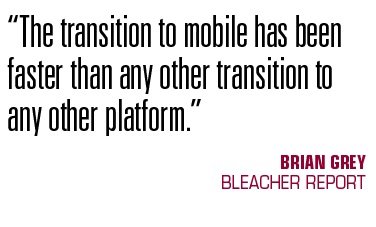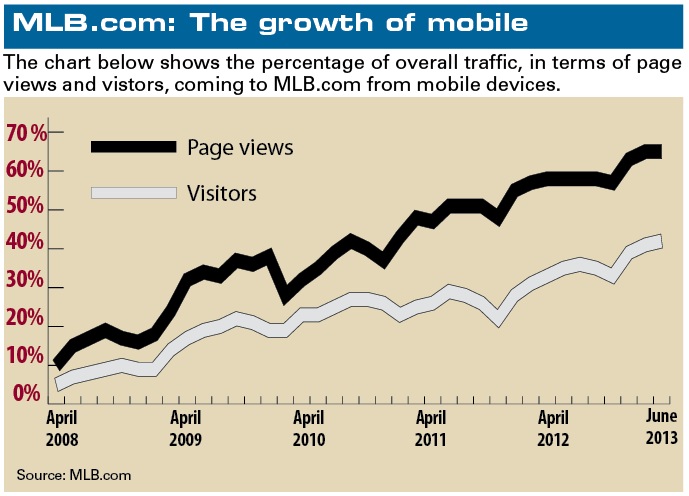MLB Advanced Media designs applications and digital video experiences for virtually every platform imaginable. But there’s a basic mantra that guides the company as it determines how and when to build any particular product that could serve a screen size ranging from 2 inches to more than 100 inches.
“You have to design small then go big,” said Bob Bowman, MLBAM president and chief executive. “Everything we do now, mobile is absolutely first in the design phase, and then we move to other platforms.”
 |
Fans of the Toronto Blue Jays take a photo on their mobile device. The traffic generated through such devices has changed how digital content is packaged and presented.
Photo by: Getty Images |
Not long ago, this wasn’t the case. For all the advances in mobile technology, traffic from desktop and laptop computers has held the dominant share of total digital audiences in the sports sector. That traditional online traffic also generated the vast majority of digital revenue from advertising, subscriptions and other digital commerce.
But within the last year, many of the major players in digital sports media have seen their mobile traffic, deriving from smartphones and tablets, pass 50 percent of their overall digital audience, at least in page views if not in unique visitors as well. During particularly heavy periods, such as Saturdays and Sundays during football season, the mobile traffic percentage for some major destinations can exceed 80 percent.
In numerous cases, the percentage of mobile in overall traffic has grown from less than 25 percent only two years ago to a majority share now, and that seismic shift has presented significant changes in how digital sports media operations approach their product development, programming and overall revenue generation.
It’s also manifested itself in external traffic rankings. Earlier this year, measurement firm comScore introduced its Multi-Platform Media Metrix, a new set of data that blends online, mobile and video traffic in the hopes of a truer reflection of current media consumption. And those with particularly heavy mobile traffic, such as MLB, ESPN, Bleacher Report and others, have seen their relative positions in the rankings improve significantly.
“We’re really just at the tip of the iceberg,” said Steve Raymond, USA Today Sports Media Group vice president. “The shift in traffic we’ve seen to mobile has been dramatic, particularly for some of our newer products like [social-oriented sports news site] For The Win and [mixed martial arts portal] MMA Junkie that have been at least 60 to 75 percent mobile and are really mobile-first products. But it’s where the overall portfolio, and really the overall industry, is going.”
Programming the smaller screen
The core reasons for the heavy shift to mobile for digital media are easily apparent. The last five years have seen an explosion in smartphone and tablet technology, providing near-ubiquitous access to content at ever-improving speeds. That same time period has also seen a major rise in social media networks, many of which are specifically tailored to sharing on the go.
As mainstream sports media traffic patterns now fully reflect those emerging trends, how content gets packaged and
presented is also changing dramatically.
Initially, that change meant having at least one mobile application, and a mobile-optimized version of the core website. But the thinking now goes much deeper as longer stories and pieces of content are frequently broken up into smaller, more digestible pieces, photo and video take far more prominent roles, and mobile-based social content discovery and sharing represent fundamental building blocks. Also critical is keeping as much material on the mobile Web or app home pages as possible.
“There’s definitely a heavier concentration toward more short-form edit products, things with a really quick turnaround, and deliberately timing more of the longer-form material to weekends, evenings and other periods where it can be consumed better,” said Shannon Terry, founder and chief executive of 247Sports.com.
“Everything new that we do, such as our Crystal Ball [recruiting projector], has to be completely tailored for mobile. Otherwise, it pretty much negates the benefit of having the new product in the first place,” Terry said.
Brian Grey, chief executive of Bleacher Report, describes a mobile-fueled notion of the “real-time Web” in which a consumer expects something new every time he looks at his phone, even if it’s several times within an hour. From a metrics perspective, that dynamic of quick, repeated checks for new content predictably means lower statistics in terms of average time spent per session, but still provides payback in the form of repeat, habitual usage.
“The transition to mobile has been faster than any other transition to any other platform,” Grey said. One of the company’s signature products is its Team Stream mobile application that features running streams of news on every professional and major college team. As a result, the company’s mobile traffic has surged from less than 20 percent of its overall consumption two years ago to nearly 60 percent now.
“So now this real-time Web is fully upon us, and it’s something that every publisher is grappling with,” he said.
Similarly, Sports Illustrated’s new Peter King-led initiative, TheMMQB.com, is a “mobile-first effort” that features a steady flow of content, mostly short-form material, throughout each weekday.
“It’s not just resizing or reformatting the content to make it work for mobile,” said Jim DeLorenzo, SI Digital vice president and general manager. “It’s about thinking totally differently about what the mobile user wants and needs and what their consumption patterns are, but at the same time not degrading the experience for the desktop user.”
Most of the larger players in the digital space are able to develop and enhance their mobile offerings in-house, without the need to contract out work with outside agencies.
The revenue problem
For all the excitement and energy around the surge in mobile traffic, there remains a key problem: ad revenue on mobile platforms is nowhere near representative of current traffic patterns.
Digital industry forecaster eMarketer projects there will be $7.65 billion spent in total U.S. mobile advertising this
year, regardless of content genre. The figure is up a whopping 75 percent from last year, and the company also projects desktop-based digital ad spending to peak next year and then begin a slow, multiyear decline. But the mobile projection for 2013, released last month, also remains just 18 percent of the $42 billion in total projected digital ad spending this year.
Any sort of digital ad spending parity between mobile and desktop platforms is at least four to five years away, according to further eMarketer projections.
“That’s the rub,” Terry said. “There’s still a great disparity, and monetization on mobile is still a challenge. You’re dealing with smaller [ad rates] and obviously a much smaller screen to work with in terms of what you can offer a brand marketer.”
There are several factors behind the ad spending-traffic divide. Ad-targeting technologies for mobile platforms are not yet as developed as those for desktops. Many consumers are far more resistant to ad overlays, borders or video pre-rolls on their phones and tablets than they are on their computers.
More than a decade after the mainstream advent of the wired Web, digital ad spending is still catching up to traditional platforms, and itself does not yet generate revenue commensurate with audience consumption. But industry executives believe the catchup period for mobile will be shorter.
There also has been a high degree of experimentation within the mobile advertising space, trying to find placements and activations that will provide value to marketers without compromising the user experience.
Atlanta-based digital agency CSE, for example, has worked with brands such as AT&T and Coke Zero to have title branding on college sports-related mobile apps (see related story). MLBAM, similarly, has sold a title sponsorship to its Beat The Streak app, currently held by Dunkin’ Donuts, and has virtual corporate signage from Sony within its mobile Gameday game tracker, similar to what is commonly done in console-based video games.
Additionally, many major digital sports publishers have now grown much more aggressive about packaging their mobile ad sales with other platforms, including traditional ones such as print and TV, with the intent of having the cross-platform sell act as an entry point for marketers and brands to better understand mobile.
“The multi-platform approach, not keeping mobile on an island unto itself, and having that 360-degree approach to extend narratives seamlessly across platforms is an important part of this,” Grey said.








